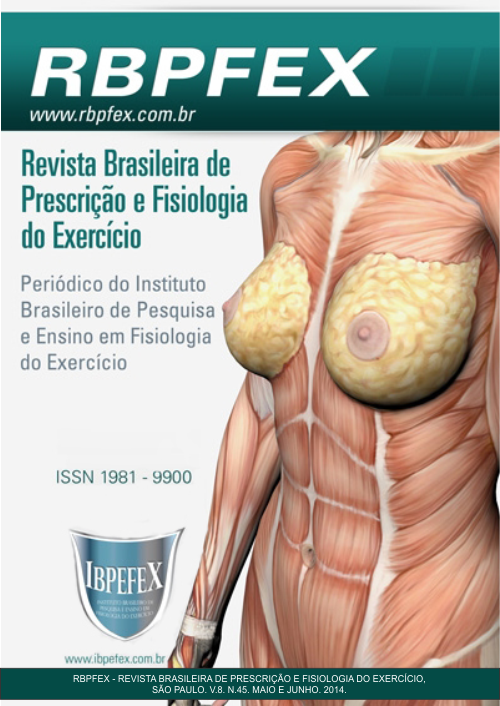Metabolic response to exercise in subjects with diabetes type 2: a systematic review
Abstract
This article reviewed the literature with authors declared present the metabolic responses to the use of aerobic and / or anaerobic regular exercise in the prevention and treatment of DM. Especially fortype 2 because exercises provides to the type 1 diabetics subjects physiological changes. The aims of this study are to present, through a scientific literature review, the metabolic responses during physical exercise in the treatment and prevention of type 2 diabetes. This is a research type of systematic review of the literature, using primary and secondary search in computerized databases, national and international articles in Portuguese and English, from 1990 to 2010. The research resulted from the analysis of 12 articles that presented results of 12 studies with more than 2.751 human 18-80 years. The work supports the evidence that exercise has the metabolic response to reduced levels of blood glucose, lipid profile, decreased heart rate (HR) at rest,lowering blood pressure and changes in body mass index (BMI) in type 2 diabetics.
References
-Brandenberg, S. L.; Reusch, J. E.B.; Bauer,T. A.; Jeffers, B.; Hiatt, W. R.; Regensteiner, J. G. The ffects of exercise training on oxygen uptake kinetic responses in women with type 2 diabetes. Diabetes Care. Vol. 22. p. 1640-1646, 1999.
-Cauza, E.; Hanusch-Enserer, U.; Strasser, B.; Ludvik, B.; Metz-Schimmerl, S.; Pacini, G.; Wagner, O.; Georg, P.; Prager, R.; Kostner, K.; Dunky, A.; Haber, P. The relative benefits of endurance and strength training on the metabolic factors and muscle function of people with type 2 diabetes mellitus. Arch Phys Med Rehabil. Vol. 86. p. 1527-33. 2005.
-Danilo, D. P.M.; Mattos, M. S.; Higino, W. P. Efeitos do treinamento resistido em mulheres portadoras de diabetes mellitus tipo 2. Departamento de educação física -Centro Universitário Católico Salesiano Auxilium-Unisalesiano, Lins-SP. Revista Brasileira de Atividade Física & Saúde. 2002.
-Dunstan, D. W.; Daly, R. M.; Owen, N.; Jolley, D.; Courten, M.; Shaw, J.; Zimmet, P. High-intensity resistance training improves glycemic control in older patients with type 2 diabetes. Diabetes Care. Vol. 25. p. 1729-1736. 2002.
-Felippe, J.; Iop, R. R. Efeito combinado do exercício aeróbio e resistido em indivíduos hiperglicêmicos. Universidade do Sul de Santa Catarina. 2010.
-Hayashi, T.; Jorgen F. P.; Wojtaszewski; Laurie, J. G. Exercise regulation of glucose transport in skeletal muscle. American Jornal Physiologic 273. Endocrinolog Metabolic. Vol. 36. p. E1039-E1051. 1997.
-Miller, J. P.; Pratley, R. E.; Goldberg, A. P.; Gordon, P.; Rubin, M.; Treuth, M. S.; Ryan, A. S.; Hurley, B. F. Strength training increases insulin action in healthy 50-to 65yr-old men. American Physiological Society. Vol. 77. Núm. 3. 1994.
-Pereira, C. A. Efeito do treinamento aeróbio sobre a microalbuminúria em indivíduos diabéticos tipo 2. TCC de graduação. Bauru-SP. Universidade Estadual Paulista Júlio de Mesquita Filho. 2008.
-Shaibi,G. Q.; Cruz,M. L.; Ball,G. D. C.; Weigensberg, M. J.; Salem,G. J.; Crespo, N. C.; Goran, M. I. Effects of resistance raining on insulin sensitivity in overweight latino adolescent males. Medicine and Science in Sports and Exercise. Vol. 38. Núm. 7. p. 1208 -1215. 2006.
-Silva, C. A.; Lima W. C. Efeito benéfico do exercício físico no controle metabólico do diabetes mellitus tipo 2 a curto prazo. Arquivo Brasileiro de Endocrinologia e Metabolismo. Vol. 46. Núm. 5. p. 550-556. 2002.
-Tabata, I.; Suzuki, Y.; Fukunaga, T.; Yokozeki, T.; Akima, H.; Funato, K. Resistance training affects GLUT-4 content in skeletal muscle of humans after 19 days of head-down bedrest. American Physiological Society. Vol. 99. 1999.
-Tremblay, A.; Despres, J-P.; Leblanc, C.; Craig, C. L.; Ferris, B.; Stephens, T.; Bouchard, C. Effect of intensity of physical activity on body fatness and fat distribution. American Jornal Clinic Nutricion. Vol. 51. p. 153-7. 1990.
Authors who publish in this journal agree to the following terms:
- Authors retain the copyright and grant the journal the right of first publication, with work simultaneously licensed under the Creative Commons Attribution License BY-NC which allows the sharing of the work with acknowledgment of the authorship of the work and initial publication in this journal.
- Authors are authorized to enter into additional contracts separately for non-exclusive distribution of the version of the work published in this journal (eg, publishing in institutional repository or book chapter), with acknowledgment of authorship and initial publication in this journal.
- Authors are allowed and encouraged to post and distribute their work online (eg, in institutional repositories or on their personal page) at any point before or during the editorial process, as this can bring about productive change as well as increase impact and impact. citation of published work (See The Effect of Free Access).






